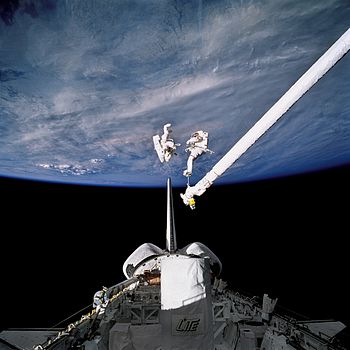STS-64
Lua error in package.lua at line 80: module 'strict' not found.

Astronauts Lee and Meade perform an EVA in Discovery's payload bay
|
|||||
| Mission type | Research Technology |
||||
|---|---|---|---|---|---|
| Operator | NASA | ||||
| COSPAR ID | 1994-059A | ||||
| SATCAT № | 23251 | ||||
| Mission duration | 10 days, 22 hours, 49 minutes, 57 seconds | ||||
| Distance travelled | 7,242,048 kilometers (4,500,000 mi) | ||||
| Orbits completed | 176 | ||||
| Spacecraft properties | |||||
| Spacecraft | Space Shuttle Discovery | ||||
| Payload mass | 9,260 kilograms (20,410 lb) | ||||
| Crew | |||||
| Crew size | 6 | ||||
| Members | Richard N. Richards L. Blaine Hammond, Jr. Jerry M. Linenger Susan J. Helms Carl J. Meade Mark C. Lee |
||||
| Start of mission | |||||
| Launch date | 9 September 1994, 22:22:35 UTC | ||||
| Launch site | Kennedy LC-39B | ||||
| End of mission | |||||
| Landing date | 20 September 1994, 21:12:52 UTC | ||||
| Landing site | Edwards Runway 4 | ||||
| Orbital parameters | |||||
| Reference system | Geocentric | ||||
| Regime | Low Earth | ||||
| Perigee | 259 kilometres (161 mi) | ||||
| Apogee | 269 kilometres (167 mi) | ||||
| Inclination | 56.9 degrees | ||||
| Period | 89.5 min | ||||

|
|||||
STS-64 was a Space Shuttle Discovery mission to perform multiple experiment packages. It was launched from Kennedy Space Center, Florida, on 9 September 1994.
Crew
| Position | Astronaut | |
|---|---|---|
| Commander | Richard N. Richards Fourth spaceflight |
|
| Pilot | L. Blaine Hammond, Jr. Second spaceflight |
|
| Mission Specialist 1 | Jerry M. Linenger First spaceflight |
|
| Mission Specialist 2 | Susan J. Helms Second spaceflight |
|
| Mission Specialist 3 | Carl J. Meade Third spaceflight |
|
| Mission Specialist 4 | Mark C. Lee Third spaceflight |
|
Spacewalks
- Lee and Meade – EVA 1
- EVA 1 Start: 16 September 1994 – 14:42 UTC
- EVA 1 End: 16 September 1994 - 21:33 UTC
- Duration: 6 hours, 51 minutes
Mission highlights
STS-64 marked the first flight of Lidar In-space Technology Experiment (LITE) and the first untethered U.S. extravehicular activity (EVA) in 10 years. LITE payload employs lidar, which stands for light detection and ranging, a type of optical radar using laser pulses instead of radio waves to study Earth's atmosphere. The first spaceflight of lidar was a highly successful technology test. The LITE instrument operated for 53 hours, yielding more than 43 hours of high-rate data. Unprecedented views were obtained of cloud structures, storm systems, dust clouds, pollutants, forest burning and surface reflectance. Sites studied included atmosphere above northern Europe, Indonesia and the south Pacific, Russia and Africa. Sixty-five groups from 20 countries made validation measurements with ground-based and aircraft instruments to verify LITE data. The LITE science program wad part of NASA's Mission to Planet Earth.
Mission Specialists Lee and Meade completed the 28th EVA of the Space Shuttle program on 16 Sept. During the six-hour, 15- minute EVA, they tested a new backpack called Simplified Aid for EVA Rescue (SAFER), designed for use in event crew member becomes untethered while conducting an EVA. Operations with SAFER marked the first untethered EVA since STS 51-A in 1984, and also the last such EVA of the program. SAFER went on to become a mainstay of US and joint spacewalks during the assembly of the International Space Station and beyond.
On the fifth day of the mission, the Shuttle Pointed Autonomous Research Tool for Astronomy-201 (SPARTAN-201) free flyer was released using the Remote Manipulator System arm. Making its second flight on the Shuttle, SPARTAN-201 was designed to collect data about the acceleration and velocity of the solar wind and to measure aspects of sun's corona. Data was recorded for playback after return to Earth. SPARTAN-201 was retrieved after two days of data collection.
Other cargo bay payloads: Shuttle Plume Impingement Flight Experiment (SPIFEX), a 33-foot (10-meter) long instrumented extension for Shuttle robot arm. SPIFEX designed to collect data about orbiter Reaction Control System (RCS) thrusters to aid understanding about potential effects of thruster plumes on large space structures, such as Mir space station or the planned international space station. The Robot Operated Processing System (ROMPS) was the first U.S. robotics system operated in space, mounted in two Get Away Special (GAS) canisters attached to the cargo bay wall. A GAS bridge assembly in the cargo bay carried 12 cans, 10 holding self-contained experiments.
Middeck experiments included: Biological Research in Canister (BRIC) experiment to investigate effects of spaceflight on plant specimens; Military Application of Ship Tracks (MAST) to take high-resolution imagery of ship tracks and to analyze wake formation and dissipations; Solid Surface Combustion Experiment (SSCE) to supply information on flame propagation over fuels in space; Radiation Monitoring Equipment III (RME III) to measure ionizing radiation; Shuttle Amateur Radio Experiment II (SAREX II) to demonstrate feasibility of short-wave radio contacts between orbiter and ground-based amateur radio operators; and Air Force Maui Optical Station (AMOS) test, which required no onboard hardware.
STS-64 was the first mission to see the use of the new full-pressure Advanced Crew Escape Suit,[1] which eventually replaced the partial-pressure Launch Entry Suit.
See also
- Space science
- Space shuttle
- List of space shuttle missions
- List of human spaceflights chronologically
References
![]() This article incorporates public domain material from websites or documents of the National Aeronautics and Space Administration.
This article incorporates public domain material from websites or documents of the National Aeronautics and Space Administration.



